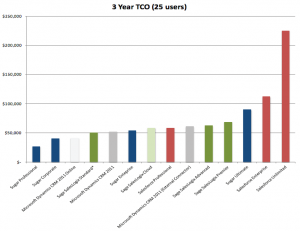 If you download this White Paper you will know about a recent study by Nucleus Research indicated that, for every dollar spent on customer relationship management (CRM) by “Nucleus” clients, $5.60 in value was returned. Many CRM vendors’ products were used by these customers, indicating that well-managed CRM efforts deliver significant ROI. However, there was no breakout of which vendors’ implementations delivered the biggest benefits, nor was there any mention of the total cost of ownership (TCO) for any vendor’s product. Logic holds that a CRM application with a lower TCO confers far greater value per dollar than an application with a higher TCO.
If you download this White Paper you will know about a recent study by Nucleus Research indicated that, for every dollar spent on customer relationship management (CRM) by “Nucleus” clients, $5.60 in value was returned. Many CRM vendors’ products were used by these customers, indicating that well-managed CRM efforts deliver significant ROI. However, there was no breakout of which vendors’ implementations delivered the biggest benefits, nor was there any mention of the total cost of ownership (TCO) for any vendor’s product. Logic holds that a CRM application with a lower TCO confers far greater value per dollar than an application with a higher TCO.
This study comes as the way companies use and pay for CRM applications is changing. Instead of a predominantly perpetual license-based system, where companies paid a large up-front sum and then smaller annual maintenance fees, CRM software providers are now moving towards monthly or annual subscription fees to access CRM software on the Internet.
The various pricing schemes can create confusion among buyers as they try to assess the total cost of ownership of different CRM services priced under various schemes. For example, there are still several companies offering licensebased pricing models. Also, some companies offer a subscription option in addition to a perpetual license option. The following analysis provides a compares the prices of four leading CRM solutions for midmarket organizations.
Forrester Research defines a midmarket organization as any organization with revenues of less than $1 billion and/or fewer than 1,000 employees. The CRM solutions included in this TCO analysis are:
For this analysis we looked at the following costs and requirements: for premise-based solutions we included the server and end-user (named user) licenses and annual support and maintenance fees. For on-demand solutions we looked at the annual end-user (named user) subscription fees. Each solution had to include mobile access, integration with Microsoft Outlook, a customizable reporting engine and configuration and customization capabilities.
We looked at the three-year TCO (total cost of ownership) for a 10-user; 25-user; 100-user and 500-user deployment. We are assuming the following storage requirements: 5GB for the 10-user; 10GB for the 25-user; 15GB for the 100-user and 25GB for the 500-user deployments. For this analysis, we used standard list pricing as available in February 2012. Term, volume and other discounts (such as discounts available under the Microsoft Enterprise Agreement) have not been considered.
Hardware costs for on-premise deployments, such as servers, security firewalls, and other associated costs such as human capital, which are needed to maintain these systems, have not been included in this cost analysis. All price information is sourced from reputable web sites and referenced throughout the analysis.